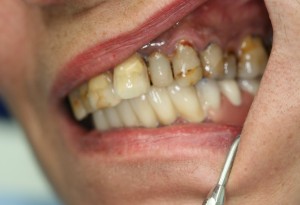Dental implantation and smoking

Dental implantation and smoking - almost incompatible things, because smoking dramatically reduces the success of osseointegration and increases the risk of rejection of implants.
If the patient smokes, then, at best, for a couple of weeks he will have to give up this habit.
During smoking, a low pressure is created in the oral cavity, which prevents the formation of a blood clot, which is necessary for the healing of damaged tissues.
In addition, nicotine in tobacco smoke constricts blood vessels.
Smoking and dental treatment
- Patients who smoke tolerate much more difficult even such a simple effect on the body as tooth extraction. Complications after tooth extraction are much more common in them.
- When smoking, the bone tissue surrounding the tooth is rapidly destroyed. If implantation is required - a lack of bone tissue is one of the serious contraindications to it.
- In the case of bone grafting, the healing time of the tissues increases.
- The effect of nicotine has a negative effect on the body's immune system, which leads to periodontal disease.
- Smoking can be one of the causes of cancer of the oral mucosa, jaw osteomyelitis.
- After implantation, the period of tissue healing and implant engraftment increases.
- Smoking after dental implants increases the risk of implant rejection.
Smoking and the consequences of implantation
Smoking has a negative effect not only on the body, but also on implantation.
- In non-smokers, complications after surgery occur in less than 3% of cases.
- In smokers, the frequency of complications increases to 10%.
Complications after surgery

- Long healing of the wound surface.
- The process of osseointegration is quite slow.
- The risk of complications increases, both during and after surgery.
- If bone building is performed, then the risk of material rejection increases.
- Seam discrepancy after surgery.
- Strengthening the formation of plaque on the teeth, gums and the upper part of the implant.
- High probability of mobility and prolapse of the implant.
Dentists argue that the percentage of rejection of implants in smokers is higher than in non-smokers.
- Research data suggests that those who smoke only in 86% of cases 5 years after surgery have implants that can perform their functions normally.
- In non-smokers, 95% of the implants function normally 10 years after their installation.
Causes of rejection of implants during smoking
- Inadequate hygienic care of the oral cavity, because after smoking there is increased deposition of plaque, bacterial growth and the development of diseases are accelerated.
- Resins contained in cigarettes, as well as hot smoke, are a damaging factor, cause burns and tissue irritation, which slows the recovery of damaged areas.
- The process of tissue regeneration and restoration of normal blood circulation is slow, which leads to a slow engraftment of the implant.
- Smokers are more likely to become infected at the implant site.
How to prepare for implantation
Smoking is a special risk factor for dental implants.
At least two to three weeks before the proposed operation, you must quit smoking or minimize the number of cigarettes smoked per day. It is also necessary to refrain from smoking after installing implants for a period of at least one and a half months.
The effect of smoking on implants
- Tissue infection at the site of the installation promotes its rejection.
- Enhanced formation of bacterial deposits reduces the life of the implants.
- Duration of use of dentures is reduced.
Since smoking is a risk factor that jeopardizes the success of dental implants, it must be eliminated before surgery can begin.